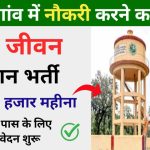Bhunaksha Online: The Bhu Naksha system in India is a vital tool for landowners, buyers, and developers, providing access to cadastral maps that detail land ownership, boundaries, and other essential information. The digitization of land records through initiatives like BhuNaksha has made it easier for citizens to access their land maps online without the need to visit government offices.
This article will guide you through the process of checking your village land map using BhuNaksha online, covering its significance, features, and state-specific procedures.
Understanding Bhunaksha Online
Bhu Naksha refers to the digital representation of land parcels within a specific area, showing details such as:
- Land Boundaries: Clear demarcation of property lines.
- Ownership Information: Names of landowners associated with each parcel.
- Survey Numbers: Unique identifiers for each plot of land.
- Land Use: Information about how the land is utilized (agricultural, residential, commercial, etc.).
Importance of Bhu Naksha
- Transparency in Land Ownership: Bhu Naksha provides a clear visual representation of property boundaries, helping to verify ownership and reducing disputes.
- Conflict Resolution: It assists in resolving boundary disputes by providing an accurate depiction of land ownership.
- Legal Authentication: Bhu Naksha maps are often required for legal documentation during property transactions.
- Integration with Other Records: The system is linked with other important land records like Record of Rights (RoR), mutation records, and property tax receipts.
How to Access Bhu Naksha Online
Accessing your village land map through Bhu Naksha involves visiting your state’s official land records portal. Here’s a step-by-step guide to help you navigate the process:
General Steps to Check Your Land Map
- Visit the Official Portal: Search for your state’s specific Bhu Naksha portal (e.g., “Bhu Naksha [State Name]”).
- Select District and Tehsil: Choose your district and tehsil or taluka from the dropdown menus provided.
- Enter Relevant Details: Input necessary information such as the survey number, village name, or owner’s name.
- Access Land Records: View and download the corresponding cadastral map.
State-wise Procedures for Accessing Bhu Naksha
Different states in India have their own portals for accessing Bhu Naksha. Below are specific instructions for several key states:
1. Uttar Pradesh
- Portal: UP Bhulekh
- Steps to Check Land Map:
- Go to the UP Bhulekh portal.
- Select ‘Janpad’ (district) from the left menu.
- Choose your tehsil and village name.
- Enter details such as Khasra number or owner’s name.
- Click on ‘Search’ to view the land map.
2. Maharashtra
- Portal: Maha Bhulekh
- Steps to Check Land Map:
- Visit the Maha Bhulekh portal.
- Select your district and taluka.
- Enter survey number or Khasra number.
- Access the map and download it if needed.
3. Rajasthan
- Portal: Rajasthan Bhulekh
- Steps to Check Land Map:
- Navigate to the Rajasthan Bhulekh portal.
- Choose your district and tehsil from the dropdown menus.
- Enter relevant details like Khasra number or owner’s name.
- Click ‘View’ to access the cadastral map.
4. Punjab
- Portal: Punjab Bhulekh
- Steps to Check Land Map:
- Go to the Punjab Bhulekh portal.
- Select your district and village.
- Enter details such as Khasra number or owner’s name.
- View and download your land map.
5. Bihar
- Portal: Bihar Bhulekh
- Steps to Check Land Map:
- Visit the Bihar Bhulekh portal.
- Click on ‘Jamabandi Panji dekhe’ (View Jamabandi).
- Select district, tehsil, and village from dropdowns.
- Enter required details and click ‘Search’ to view the map.
6. Odisha
- Portal: Bhulekh Odisha
- Steps to Check Land Map:
- Go to the Bhulekh Odisha portal.
- Choose ‘ROR View’ from the menu options.
- Enter details such as district and plot number.
- Access your land map along with ownership details.
Additional States
Most Indian states have established their own portals under various initiatives aimed at digitizing land records:
| State | Portal Link | Key Features |
|---|---|---|
| Madhya Pradesh | MP Bhulekh | User-friendly interface for easy navigation |
| Andhra Pradesh | Meebhoomi | Access to Adangal records |
| Telangana | Dharani Portal | Comprehensive land record access |
| Delhi | Delhi Bhulekh | Access Khasra Khatauni records |
Benefits of Using Bhu Naksha
Using Bhu Naksha offers several advantages:
- Convenience: Citizens can access their land maps from anywhere without visiting government offices.
- Time-Saving Process: The online system reduces time spent on obtaining land-related information.
- Reduced Corruption Opportunities: Direct access minimizes chances for corruption or manipulation by intermediaries.
- Improved Transparency: Public access enhances accountability among officials managing land-related services.
Challenges Faced by Users
While accessing Bhu Naksha online is generally straightforward, users may encounter challenges:
- Technical Issues: Users may face downtime or glitches on state portals due to high traffic or maintenance activities.
- Complex Navigation: Some portals may not have user-friendly interfaces, making it difficult for less tech-savvy individuals.
- Incomplete Data Updates: In some states, data may not be updated regularly, leading to discrepancies in ownership information.
Future of Bhu Naksha
The digitization of land records through systems like Bhu Naksha is part of a broader movement towards modernizing land management in India:
- Governments are investing in geospatial technologies and modern survey methods to improve accuracy.
- Future integration with blockchain technology could enhance transparency and security in property transactions by linking Bhu Naksha with immutable digital ledgers.
How can I use the Landeed app to access my village land map
The Landeed app is an innovative solution that allows users to access crucial land-related information, including village land maps, directly from their smartphones. This app simplifies the process of retrieving Bhunaksha maps, which are essential for verifying land ownership and boundaries. In this article, we will explore how to use the Landeed app to access your village land map, the features it offers, and its significance in managing land records.
Understanding the Landeed App
The Landeed app provides a user-friendly platform for accessing various land records, including Bhunaksha maps. It is designed to make the process of obtaining land information more efficient and accessible for everyone, particularly those who may not be familiar with traditional government portals.
Key Features of the Landeed App
- Instant Access to Bhunaksha Maps: Users can quickly search for their land maps by entering relevant details like survey numbers or property addresses.
- Comprehensive Land Records: In addition to Bhunaksha maps, the app provides access to other essential documents such as 7/12 extracts, mutation records, and property tax receipts.
- User-Friendly Interface: The app is designed for ease of use, making it accessible even for those who may not be tech-savvy.
- Mobile Accessibility: Being a mobile application, it allows users to check land records anytime and anywhere without needing a computer.
- Integration with Government Databases: The app connects with state government databases to provide up-to-date information on land records.
How to Use the Landeed App to Access Your Village Land Map
Using the Landeed app to access your village land map is a straightforward process. Here’s a step-by-step guide:
Step 1: Download the Landeed App
- For Android Users: Go to the Google Play Store and search for “Landeed.” Download and install the app on your smartphone.
- For iOS Users: Check the Apple App Store for availability and download it if it’s offered.
Step 2: Create an Account or Log In
- Open the app after installation.
- If you are a new user, you may need to create an account by providing basic information such as your name, email address, and phone number.
- If you already have an account, simply log in using your credentials.
Step 3: Navigate to Land Records
- Once logged in, look for the option labeled “Bhunaksha” or “Land Records” on the home screen.
- Tap on this option to proceed.
Step 4: Enter Property Details
- You will be prompted to enter specific details about your property:
- Survey Number: This is a unique identifier assigned to each plot of land.
- Village Name: Specify the name of your village where the land is located.
- Alternatively, you may also search using other identifiers like Khasra number or owner’s name.
Step 5: Access Your Village Land Map
- After entering the required information, tap on “Search” or “View.”
- The app will retrieve the Bhunaksha map corresponding to your property details.
- You can view the map directly on your device and zoom in or out for better clarity.
Step 6: Download or Share the Map
- If you need a physical copy or want to share it with others:
- Look for options like “Download” or “Share.”
- Save it as a PDF or image file on your device or share it via email or messaging apps.
Benefits of Using Landeed App for Land Records
- Convenience: Accessing land maps through a mobile app is significantly more convenient compared to visiting government offices or navigating complex state portals.
- Time-Saving: Users can quickly find and verify land information without lengthy procedures.
- Real-Time Updates: The app provides access to real-time data from government databases, ensuring that users have the most current information available.
- Enhanced Transparency: By allowing direct access to land records, Landeed promotes transparency in property transactions and ownership verification.
- Support for Legal Transactions: The availability of accurate land maps aids in legal processes related to property sales, purchases, and disputes.
Importance of Bhunaksha Maps
Bhunaksha maps play a crucial role in various aspects of land management:
- Boundary Verification: They help clarify property boundaries and ownership details, reducing disputes between neighbors.
- Legal Documentation: Bhunaksha maps are often required for legal documentation during property transactions, ensuring legitimacy.
- Urban Planning and Development: These maps assist urban planners and developers in understanding land use patterns and planning infrastructure projects effectively.
Common Issues and Solutions When Using Landeed
While using the Landeed app can be straightforward, users may encounter some common issues:
- Data Inaccuracies:
- If you notice discrepancies in the map data compared to physical boundaries, contact local authorities or use grievance redressal mechanisms provided by state governments.
- Technical Glitches:
- Ensure that you have a stable internet connection while using the app. If issues persist, try restarting the app or checking for updates.
- Limited Availability in Some Regions:
- The availability of certain features may vary based on state regulations. Check if your state is supported by Landeed for accessing specific records.
Conclusion
The Bhu Naksha system is a crucial component in managing land records in India, providing citizens with easy access to vital information about their properties. By understanding how to navigate state-specific portals effectively, individuals can verify ownership details, resolve disputes, and facilitate smoother property transactions.
As technology continues to evolve, initiatives like Bhu Naksha will play an increasingly important role in ensuring transparency and efficiency in India’s real estate sector, ultimately benefiting all stakeholders involved—from individual farmers and homeowners to large-scale developers and government authorities alike.
By leveraging these digital tools, citizens can empower themselves with knowledge about their land holdings while contributing positively to India’s agricultural landscape and urban development efforts.








